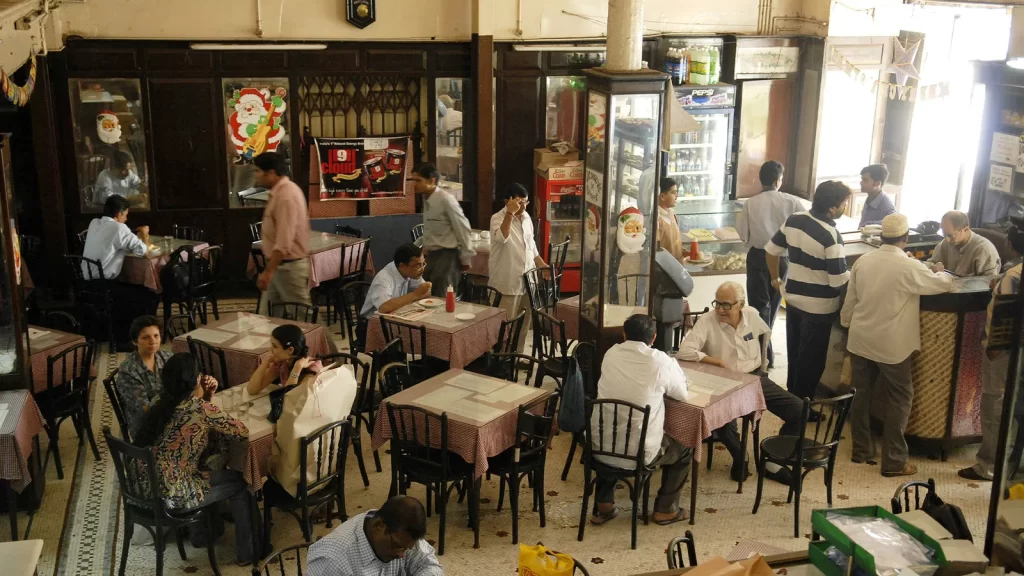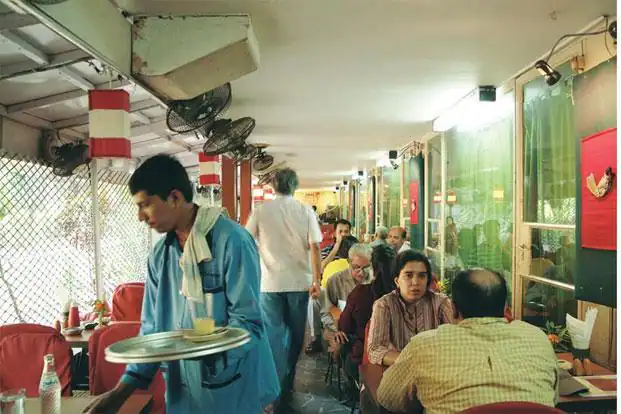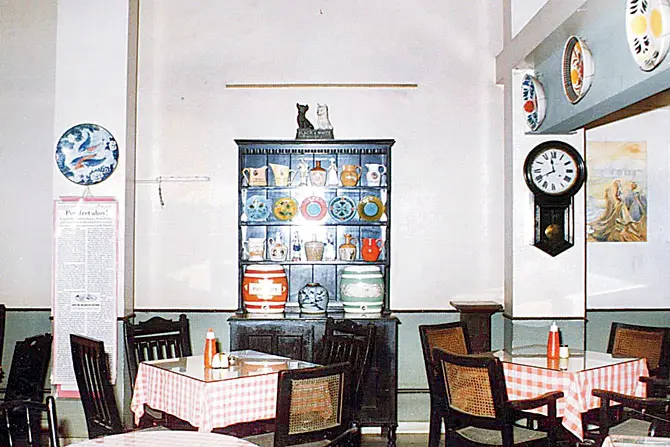Up and down the whole hungry longitude
AUTHOR
Avani Tandon Vieira
On the corner of Rampart Row, across from Rhythm House in Bombay’s Kala Ghoda district, poet and artist Arun Kolatkar sits at a table at the Wayside Inn. It is a Thursday afternoon in the 1960s, and like every other Thursday, Kolatkar is gradually joined by friends and acquaintances – painters, poets, editors – who drop in for a conversation, to read a new poem or to hear one read, or simply for a cup of tea.
The Wayside Inn has stood at this spot for nearly five decades. Taken over from an Englishwoman by the Parsi Patel family in 1933, the restaurant serves a mix of foods as eclectic as its history – fish and chips served alongside spaghetti Bolognese and mutton Dhansak. Its mismatched tables and triangular, high-ceilinged interiors welcome intellectuals, poets, and statesmen, casual conversations at one table, drafts of the constitution at another[1]. On this Thursday, its corner table hosts, among others, one of the foremost Indian poets of the twentieth century.
From his vantage point at the Inn, sometimes accompanied, sometimes not, Kolatkar watches the city go by. A watermelon seller pushes his cart through the streets as an idli vendor sets up shop. A fisherwoman on her way to work stops for breakfast at a tea stall. The rat poison man puts his wares aside, settles on the pavement, and has his lunch. The city rises and rests, opens and closes, eats and eats and eats.
For Kolatkar and his circle of contemporaries, the Wayside Inn is part of a constellation of sites – cafés and restaurants and bookshops – that make up the city of the writer and the artist. Around the corner, at Café Samovar in the Jehangir Art Gallery, painters S.H. Raza, M.F. Husain, and K.H. Ara chat over Kheema Paratha and Boti Rolls. Among the checkered tablecloths and mirrored walls of dozens of Irani cafés dotting the city, writers and students alike consume bun maska and make idle conversation. The city’s eateries offer shelter, cheap nourishment, a moment of respite.

In Bombay, today as in the 20th century, all existence is precarious. To make a place for oneself is an exercise in tenacity, to make a life an exercise in resourcefulness. What is true of everyday life is true, also, of the act of artistic making. In the early decades of the nation, a self-sustaining culture of avant-garde art and writing began to emerge in Bombay. In the absence of institutional support or public recognition, young painters and poets collectivised to create modes of expression suited to their experience. Their challenge in this endeavour, alongside youth and a lack of means, was that of space.
Reflecting on the contemporary state of the American avant-garde, critic Lucy Sante argues that “an avant-garde needs a scene, and the cities are too expensive for scenes now. An avant-garde needs an excess of time, and that’s in short supply nearly everywhere”[2]. These dual concerns – of space and time – are universal. Several decades and thousands of miles away, they stood in the way of young artistic voices in 20th century Bombay. To address them, these artists turned to informal frameworks of literary-artistic assembly, frameworks that often had at their heart a food site. For filmmaker Arun Khopkar, the emergence of these spaces lies in the spontaneity of Bombay’s growth, and the absence, subsequently, of an effective plan for its development. The city’s chaotic “anti-planning”, Khopkar argues, unintentionally created “perfect incubators” for innovation in the arts; cafés, restaurants, and bookstores becoming “nerve centres” of the city’s cultural life[3]. Chief among these were the city’s many Irani cafés, which Khopkar describes as the “cheapest of subaltern clubs”.
Bombay’s Irani cafés trace their history to patterns of migration between the then neighbouring States of India and Iran. Iranian migrants travelled to India for trade and business, settling in Surat and Ahmedabad before eventually migrating to the financial capital of Mumbai. This period of resettlement in the 19th century coincided with an industrial boom, bringing thousands of workers, all in need of cheap and accessible meals, to the city[4]. Among these crosscurrents, Irani cafés provided nourishment for people of all faiths and backgrounds, serving as “a kind of poor-man’s roadside parlour where secrets and sorrows could be shared along with a leisurely cup of tea”[5]. The food served at these cafés was born of a mix of traditions, blending Iranian flavours with dishes from the Goan, Gujarati, and Mughal traditions. Gujarati staples were tempered with meat, Iranian flatbread replaced with the locally inspired brun. Blending culinary traditions and communities, Irani cafés became “Bombay’s first public eating places”[6], permitting space and time to citizens and poets alike.
In much the same way, Café Samovar was opened in 1964 in the image of Paris’ Left Bank cafés, “to fill a lacunae in the city”[7]. Where, its founder Usha Khanna found herself asking: “Would artists meet their patrons? Where would poets write without being disturbed? Where would students go on a date they could afford?”[8] The answer came in the form of the corridor-like eatery at the Jehangir Art Gallery. Samovar provided “home-style food for out-of-towners, students and other indigent Bombayites”[9], its menu an eclectic mix of dishes – Kheema Paratha, Dahi Vada, Pakodas, and Mint Tea – that were modestly priced and rarely changed. Over its nearly five-decade run, the restaurant was visited by actors and writers, lawyers and students, big names like Dilip Kumar and Husain rubbing shoulders with generations of Bombayites. In a corner of the city, sandwiched between a gallery space and a garden, the people of the city found a space for romance, small talk, art and many things in between.

Such acts of spatial remaking remain commonplace in Bombay. In a city lacking stable infrastructure, public spaces, or a robust system of libraries and art centres[10] (an accessible public commons, in other words) everyday spaces become rich, multivalent sites of community life. As the urban domain grows ever narrower, space is at once prized commodity and pliable, continually reclaimed resource. In the hands of the city’s populace, pavements become sites of commerce, traffic islands breakfast spots, and roundabouts places of leisure. Beyond the limits of the formal map is a liminal Bombay of the everyday: a set of geographic markers that exist in public memory but outside geographic fact. These landmarks of the ordinary citizen, multipurpose and movable, remake the city in the image of those who occupy it, resisting the tendency of the official map to, in the words of de Certeau, “[cause] a way of being in the world to be forgotten”[11].
Within the worlds of 20th century artmaking, the coordinates of the avant-garde performed a similar function, eking out space for practitioners who would otherwise be invisible. For the artists and writers of the 1960s, food served as link, tool, and subject. The spaces in which it was consumed were at once social and professional, allowing for nourishment and comradery alongside the development of new forms and idioms. In places like the Wayside Inn and Café Samovar, the poetic and the everyday bled into each other. These sites provided a place for food to be consumed and relished, for work to be exchanged, and for the city to be observed and documented. What emerged was a creative practice enmeshed in the texture of the city, an approach to creation deeply attuned not just to what was being said but also to where it was being said from.
Sitting at his regular table at the Wayside Inn, Kolatkar would pen dozens of poems about the lives and rhythms he was witnessing. The watermelon seller, rat poison man, and fisherwoman became his protagonists, their daily routines the subject of his work[12]. In their own ways and mediums, his contemporaries displayed a similar loving attention to the everyday, creating little magazines, paintings, and poetry that recognised the city – crowded, filthy, humble, alive – as worthy of art. In encountering portraits of the urban across aesthetic and temporal distance, it is sometimes possible to take a sanitised view of art-making, separating it from the material constraints that so often circumscribe its creation. The cultures of independent art-making in the 1960s, deeply reliant on the resources available to them, deny such distance. Instead, they deliver us to the intersection of creative practice and everyday life, revealing how the city’s cultures of eating, movement, and leisure are foundational to the art that is produced within it.
The essential question of nourishment – both metaphorical and literal – is a pathway to a fuller understanding of artistic production. In viewing the work in light of that which sustains it – space, time, resources – we may reveal the profound material requirements of creative practice. Food, as one among these, functions as a barometer of cultural life. Food is communal, public, collectively negotiated. It acts as a nucleus of social life and a marker of cultural identity. In asking who is permitted to eat, where they can eat, and what they are eating, we are asking, also, who the city belongs to.
In a sequence from his poem “Breakfast Time at Kala Ghoda”, Kolatkar records a set of meals – “khima pao at Olympia/ dal gosht at Baghdadi/ puri bhaji at Kailash Parbat…”- that is being eaten “up and down/ the whole hungry longitude”[13]. Many of the spaces in the poem are now gone, built over in the ceaseless forward march of the city. But Kolatkar’s work is more than a document of a place and time. It is a reminder of a way of being in the city, one that persists even after its coordinates have been erased. Today and tomorrow and the day after that, Bombay’s residents will find space to eat and drink and rest. They will stop on pavements and at run-down cafés for a quick meal or a slow chat. Perhaps someone will witness this and think to write about it. Perhaps not. It will happen anyway.

Works cited
Bhatia, Sidharth. “Mumbai’s iconic Café Samovar was an island of calm in a frenzied city”. Scroll.in, 19 March 2015. http://scroll.in/article/714775/mumbais-iconic-cafe-samovar-was-an-island-of-calm-in-a-frenzied-city.
Certeau, Michel de. The Practice of Everyday Life. Berkeley: University of California Press, 1984.
Guha, Kunal and Gehi, Reema, ‘‘Goodbye, Sam’s’. Mumbai Mirror.” Mumbai Mirror, 19 March 2015. Accessed 12 September 2023. https://mumbaimirror.indiatimes.com/mumbai/cover-story/goodbye-sams/articleshow/46615415.cms.
Khopkar, Arun. ‘Footloose and Fancy-Free in Bombay: A Partial View of the 1960s and 1970s’. Journal of Postcolonial Writing 53, no. 1–2 (4 March 2017): 12–24.
https://doi.org/10.1080/17449855.2017.1289612.
Kolaṭkar, Aruṇ, and Mehrotra, Arvind Krishna. Arun Kolatkar: Collected Poems in English. Tarset: Bloodaxe, 2010.
Kolaṭakar, Arun. Kala Ghoda Poems. 1st ed. Mumbai: Pras Prakashan, 2004.
Marfatia, Meher. “History and Tea at Table No. 4”. Mid-Day, 25 January 2015. https://www.mid-day.com/news/india-news/article/history-and-tea-at-table-no.-4-15940170.
Sante, Lucy. “That Moment Barely Survived”, The Drift, 9 July 2023. https://www.thedriftmag.com/that-moment-barely-survived/.
Patel, Mira. “Bun Maska and berry pulao: The history of Mumbai’s Irani cafés”. The Indian Express,12 November 2022. https://indianexpress.com/article/research/a-feast-of-berry-pulao-how-the-irani-cafes-of-bombay-served-as-socio-economic-levelers-8263822/.
Tickell, Alex. ‘Writing the City and Indian English Fiction: Planning, Violence, and Aesthetics’. In Planned Violence: Post/Colonial Urban Infrastructure, Literature and Culture, edited by Elleke Boehmer and Dominic Davies. Cham: Palgrave Macmillan, imprint of Springer Nature, 2018.
Notes
[1] B.R. Ambedkar is remembered to have drafted “his monumental work between pots of ordered tea” at the Wayside Inn in 1948. See Meher Marfatia, “History and tea at table no. 4”, Mid-Day. 25 January, 2015. https://www.mid-day.com/news/india-news/article/history-and-tea-at-table-no.-4-15940170
[2] Lucy Sante, “That Moment Barely Survived”, The Drift, Issue 10
[3] Arun Khopkar, “Footloose and Fancy-Free in Bombay: A Partial View of the 1960s and 1970s”, Journal of Postcolonial Writing, 53.1–2 (2017), pp 12–24.
[4] See Mira Patel, “Bun muska and berry pulao: The history of Mumbai’s Irani cafés”, The Indian Express. 13 November, 2022. https://indianexpress.com/article/research/a-feast-of-berry-pulao-how-the-irani-cafes-of-bombay-served-as-socio-economic-levelers-8263822/#:~:text=In%201854%2C%20a%20party%20 named,the%2019th%20century%20onwards.
[5] M G Moinuddin quoted in Mira Patel, “Bun muska and berry pulao: The history of Mumbai’s Irani cafés”.
[6] Mira Patel, “Bun muska and berry pulao: The history of Mumbai’s Irani cafés”.
[7] Khanna quoted in Kunal Guha and Reema Gehi, ‘Goodbye Sam’s”, Mumbai Mirror. 19 March, 2015. https://mumbaimirror.indiatimes.com/mumbai/cover-story/Goodbye-Sams/articleshow/46615415.cms
[8] Ibid.
[9] Sidharth Bhatia, “Mumbai’s iconic Café Samovar was an island of calm in a frenzied city”, Scroll.in. 19 March, 2015. https://scroll.in/article/714775/mumbais-iconic-cafe-samovar-was-an-island-of-calm-in-a-frenzied-city
[10] Alex Tickell argues that “the planning of the contemporary Indian city-space involves an urban apartheid where the state has abdicated any responsibility to the commons”. See “Writing the City and Indian English Fiction: Planning, Violence, and Aesthetics”, Planned Violence ed. by Elleke Boehmer and Dominic Davies (Cham: Springer International Publishing, 2018) , 206.
[11] Michel de Certeau, The Practice of Everyday Life (Berkeley: University of California Press, 1984), 97.
[12] These poems were later titled his “Kala Ghoda poems” and published posthumously in a collection by the same name. See Arun Kolatkar, Kala Ghoda Poems 1st ed (Mumbai: Pras Prakashan, 2004).
[13] See “Breakfast Time at Kala Ghoda”, Arun Kolatkar: Collected Poems in English, ed. Arvind Krishna Mehrotra, (Blooodaxe Books, 2010).
About the Author
Avani Tandon Vieira is a curator, archivist, and PhD candidate in Criticism and Culture at the University of Cambridge, where she is supported by the Gates Scholarship. Prior to beginning her doctorate, she received a bachelor’s degree in English at St. Stephen’s College, Delhi and a master’s in World Literatures at the University of Oxford. Avani’s practice is focused on minority expression, transnational exchange, and the public humanities. Her academic research considers independent publishing and global modernisms in the twentieth century, with a focus on material histories of the urban. She is interested in the politics of documentary practice, cultures of self-organising, and the relationship between space and form.

